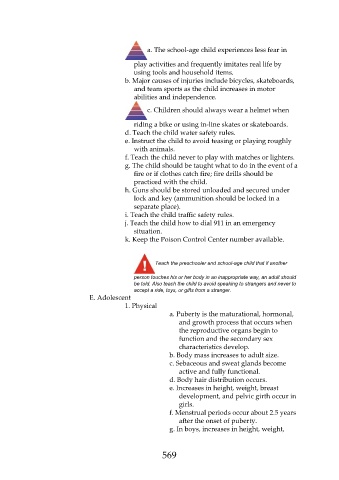Page 569 - Saunders Comprehensive Review For NCLEX-RN
P. 569
a. The school-age child experiences less fear in
play activities and frequently imitates real life by
using tools and household items.
b. Major causes of injuries include bicycles, skateboards,
and team sports as the child increases in motor
abilities and independence.
c. Children should always wear a helmet when
riding a bike or using in-line skates or skateboards.
d. Teach the child water safety rules.
e. Instruct the child to avoid teasing or playing roughly
with animals.
f. Teach the child never to play with matches or lighters.
g. The child should be taught what to do in the event of a
fire or if clothes catch fire; fire drills should be
practiced with the child.
h. Guns should be stored unloaded and secured under
lock and key (ammunition should be locked in a
separate place).
i. Teach the child traffic safety rules.
j. Teach the child how to dial 911 in an emergency
situation.
k. Keep the Poison Control Center number available.
Teach the preschooler and school-age child that if another
person touches his or her body in an inappropriate way, an adult should
be told. Also teach the child to avoid speaking to strangers and never to
accept a ride, toys, or gifts from a stranger.
E. Adolescent
1. Physical
a. Puberty is the maturational, hormonal,
and growth process that occurs when
the reproductive organs begin to
function and the secondary sex
characteristics develop.
b. Body mass increases to adult size.
c. Sebaceous and sweat glands become
active and fully functional.
d. Body hair distribution occurs.
e. Increases in height, weight, breast
development, and pelvic girth occur in
girls.
f. Menstrual periods occur about 2.5 years
after the onset of puberty.
g. In boys, increases in height, weight,
569

